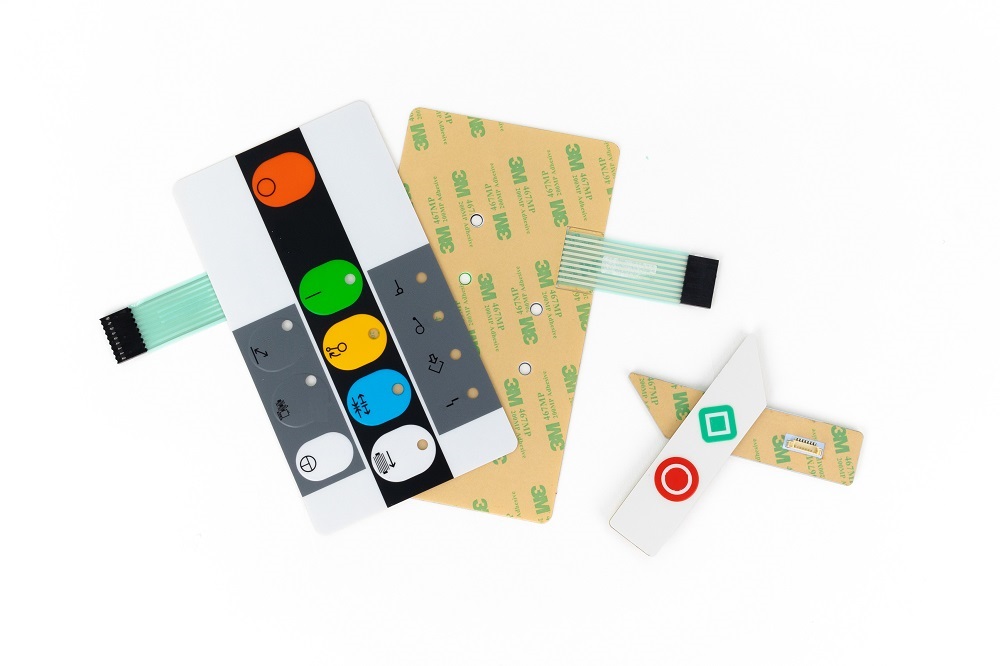Comprehending Membrane Layer Switches: The Secret to Durable and Trustworthy Controls

What Are Membrane Buttons?
Membrane layer buttons are an innovative solution in the realm of individual interface modern technology, integrating capability and design seamlessly. These gadgets serve as a user interface in between customers and digital systems, incorporating numerous parts right into a portable layout. Typically built from adaptable, slim layers of materials, membrane layer switches are designed to react to touch, allowing customers to connect with machinery and electronic tools effectively.
The main elements of a membrane switch consist of a published circuit layer, graphic overlay, and a spacer layer that stops unexpected activation. The visuals overlay can be tailored to reflect brand identity or individual choices, enhancing looks while making certain use. Membrane switches are generally made use of in different applications, including clinical gadgets, consumer electronic devices, and industrial equipment, owing to their resilience and resistance to ecological aspects such as wetness and dust.
Among the crucial advantages of membrane layer buttons is their capability to endure damage, making them excellent for high-traffic settings. Furthermore, they are lightweight and call for very little space, permitting ingenious designs in item advancement. Overall, membrane layer switches stand for a reliable and useful selection for contemporary electronic user interfaces, marrying innovation with user-centric design principles.
Just How Membrane Switches Over Work
The procedure of membrane switches joints on a simple yet efficient mechanism that equates customer input into digital signals. When a customer presses the switch, the top layer flaws, allowing a conductive component in the circuit layer to make call with a matching conductive pad on the bottom of the visuals overlay.
The layout of membrane layer switches can vary, however they often integrate domes or tactile aspects to supply comments to the customer, boosting the total experience - membrane switch. The products used in membrane layer buttons, such as polyester or polycarbonate, add to their resilience and resistance to environmental elements, including wetness and dust. The printed circuits are usually encapsulated, which safeguards them from wear and tear over time.
Benefits of Membrane Buttons

In addition, membrane switches are known for their toughness. Created from robust materials, they are resistant to dirt, wetness, and physical wear, which considerably prolongs their life-span contrasted to standard mechanical switches. This longevity makes them specifically ideal for high-traffic settings and applications calling for long life.
One more considerable benefit is the ease of cleaning and upkeep. The smooth surface area of membrane layer switches minimizes dirt buildup and is often impervious to spills, making them ideal for setups that call for constant sanitization.
Additionally, membrane layer switches provide a streamlined profile, leading to a thinner layout that can be incorporated right into numerous devices without including bulk. This attribute not only improves the aesthetic appeal but additionally adds to a more ergonomic item style.
Applications of Membrane Buttons
Flexible and easy to use, membrane buttons discover applications across a vast variety of industries, consisting of medical devices, customer electronics, and industrial tools. In the medical area, these switches are essential to tools such as analysis equipment, person tracking systems, and infusion pumps, where integrity and simplicity of cleaning are essential. Their capacity to preserve and withstand extreme environments capability makes them optimal for such applications.

In customer electronic devices, membrane buttons are used in items like microwaves, washing equipments, and remotes - membrane switch. Their smooth design permits for user-friendly interface, improving the overall customer experience while providing durability and resistance to tear and put on
Industrial devices additionally gains from membrane layer switches, specifically in control panels for read this machinery and automation systems. These buttons offer defense versus dust and dampness, making sure consistent performance in tough atmospheres. Their personalized functions allow suppliers to customize them to certain operational requirements, enhancing efficiency and capability.
Picking the Right Membrane Change
When choosing a membrane button, it is important to think about different aspects that affect efficiency and suitability for specific applications. The primary factors to consider consist of environmental conditions, responsive responses, resilience, and design specifications.
First, analyze the operating atmosphere; buttons subjected to moisture, chemicals, or extreme temperatures call for certain materials to ensure long life and performance. Next, review the requirement for tactile responses. Depending upon user communication, some applications might gain from a responsive action to confirm activation, while others might like a non-tactile design for visual reasons.
Resilience is another essential aspect; membrane buttons ought to be designed to stand up to frequent usage, effects, and abrasion. Ensure the picked switch More Info can sustain the expected lifecycle, specifically in high-usage circumstances.

Conclusion
In verdict, membrane switches offer as crucial parts in the design of durable and reliable control systems throughout different sectors. The flexibility of membrane layer changes enables for tailored solutions that fulfill look at here certain operational needs, reinforcing their relevance in contemporary innovation.
Membrane layer switches represent an essential facet of modern-day user interface design, mixing performance with durability in various applications.Membrane layer buttons are an innovative remedy in the world of customer interface modern technology, combining functionality and layout seamlessly. Generally constructed from flexible, thin layers of products, membrane layer buttons are made to react to touch, allowing individuals to engage with machinery and electronic devices effectively.
The design of membrane switches can differ, but they frequently incorporate domes or tactile elements to provide feedback to the user, enhancing the overall experience.In verdict, membrane layer switches offer as necessary elements in the design of dependable and durable control systems throughout different industries.
Comments on “How Membrane Switches Are Shaping the Future of Electronic Interfaces”